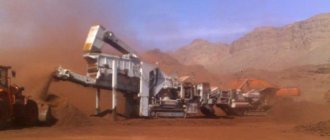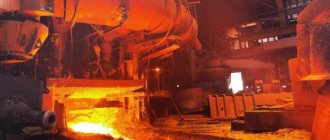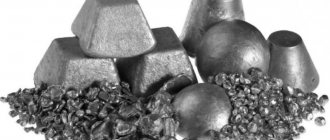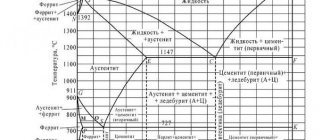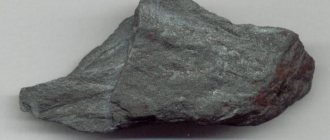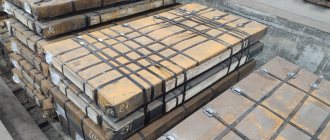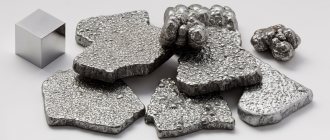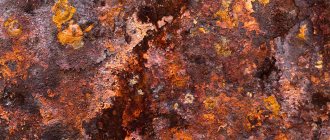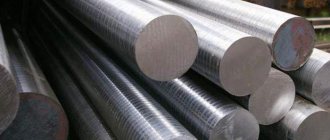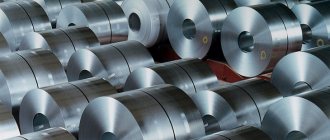Cast iron is a heavy alloy of iron with significant carbon additives (their share can reach up to 6.67 percent). Machine tools, various equipment, and metal structures are produced from it. When sold for scrap metal, they are valued inexpensively, since it is ferrous metal. Therefore, you need to understand how to quickly distinguish cast iron from aluminum, steel, and iron.
What is
Cast iron is an iron-based alloy.
Belongs to the group of ferrous metals. Ferrous metals are iron, alloys based on it (steel, cast iron, ferroalloys), manganese. According to some classifications, chromium is included in the group.
In terms of composition, cast iron is a conglomerate of iron, carbon, plus other metals. The steel formula could contain the same basic components.
The difference between these alloys is the amount of carbon. If it is less than 2.14%, it is steel. More - cast iron.
Other components are alloys and impurities (sulfur, silicon, phosphorus, manganese).
Carbon in the structure of cast iron is represented by inclusions of graphite or cementite (iron carbide, formula – Fe3C).
You can distinguish cast iron from steel visually. Steel is lighter and shiny, cast iron is dark matte.
Advantages and disadvantages
Cast iron, like any material, has positive and negative sides.
The advantages of cast iron include:
- Carbon in cast iron can be in different states. Therefore, this material can be of two types (gray and white).
- Certain types of cast iron have increased strength, so cast iron is sometimes placed on the same line as steel.
- Cast iron can maintain temperature for quite a long time. That is, when heated, the heat is evenly distributed throughout the material and remains in it for a long time.
- In terms of environmental friendliness, cast iron is a clean material. Therefore, it is often used to make dishes in which food is subsequently prepared.
- Cast iron is resistant to acid-base conditions.
- Cast iron has good hygiene.
- The material has a fairly long service life. It has been noticed that the longer cast iron is used, the better its quality.
- Cast iron is a durable material.
- Cast iron is a harmless material. It is not capable of causing even slight harm to the body.
The disadvantages of cast iron include:
- Cast iron will rust if it is exposed to water for a short time.
- Cast iron is an expensive material. However, this minus is justified. Cast iron is very high quality, practical and reliable. Items made from it are also high quality and durable.
- Gray cast iron is characterized by low ductility.
- White cast iron is characterized by brittleness. It is mainly used for smelting.
What applies to ferrous metals | Ajax-metal ✅
The definition of ferrous metals depends on the angle from which this term is viewed. From the point of view of physical properties, ferrous metals include magnetic chemical elements. Among them:
- iron;
- cobalt;
- nickel;
- gadolinium.
From a technical point of view, carbon steel and unalloyed cast iron fall under the definition of ferrous metals. The boundary between these groups of metals is determined by the carbon content in the alloys: less than 2.14% is steel, 2.14% and above is cast iron.
Story
The documented history of cast iron starts from the 1st millennium BC:
- Smelting was mastered by the Chinese and their neighbors.
- From the 5th century BC, the period of decorative iron casting began.
- 600 years later, coins appeared in China.
The appearance of the alloy in Europe dates back to the 14th century, in Russia – two hundred years later. Interest increased due to the suitability of cast iron as a material for cannons and cannonballs.
Eglinton Tournament Bridge (completed c. 1845), North Ayrshire, Scotland, built of cast iron
Since the time of Queen Victoria, fireplaces have become the most popular product in the “civil segment” among the British.
Cast iron coal iron
The heyday of the cast iron industry in Russia dates back to the 18th century:
- Bridges and rails appeared.
- Cast iron pots were invented in the Urals - the number one cookware for the Russian stove. Later they were supplemented with frying pans.
- By the end of the century, Russia had become the world leader in the production of cast iron.
The original bridge across the Tey from the north (finished in 1878)
The openwork products of Kasli craftsmen have gained world fame.
The method of molding for casting artistic castings of complex shapes, invented by the Kasli people, is still in demand by machine builders today.
Structure and composition
If we consider cast iron as a structural material, then it is a metal cavity with graphite inclusions. The structure of cast iron is mainly pearlite, ledeburite and ductile graphite. Moreover, for each type of cast iron these elements predominate in different proportions or are absent altogether.
According to the structure of cast iron there are:
- perlite,
- ferritic and
- ferritic-pearlitic.
Graphite is present in this material in one of the forms:
- Globular. Graphite takes on this shape when magnesium is added. The spherical shape of graphite is characteristic of high-strength cast irons.
- Plastic. Graphite is similar to the shape of petals. In this form, graphite is present in ordinary cast iron. This cast iron has increased ductility properties.
- Flaky. Graphite acquires this shape by annealing white cast iron. Graphite is found in flake form in malleable cast iron.
- Vermicular. The named form of graphite is found in gray cast iron. It was developed specifically to improve ductility and other properties.
Influence of impurities on material properties
The components that make up cast iron affect the quality of the alloy:
- sulfur helps reduce the refractoriness and fluidity of cast iron;
- phosphorus reduces strength, but makes it possible to vary the shape of finished products;
- silicon reduces the melting point of the metal and enhances its casting properties. In addition, this element makes it possible to obtain alloys of different colors: from pure white to ferritic;
- manganese gives cast iron strength and hardness, but reduces the casting and technological properties of the finished material;
- the introduction of titanium, aluminum, chromium, nickel or copper into the composition allows the production of alloyed alloys. They have high casting qualities and have proven good machinability. Production technology
Cast iron cast in the form of pigs
The source of raw materials for metallurgists is iron ores (rocks with a predominance of iron in the composition).
The ore is sent to processing plants, where part of the “empty” material is removed from the raw material.
The resulting material is transported to the metallurgical plant.
Here they are loaded into blast furnaces:
- Fuel is added - coke (a product of processing coal), limestone, briquetted coal dust.
- Melts at high temperatures.
- During the reduction process, iron with carbon embedded in its structure is obtained from oxides.
As a result of smelting, cast iron and slag are formed (a mixture of fuel ash, unused fluxes, and other products).
Ligatures are added if necessary. They determine the physical and chemical properties of the material.
Production is simple, but environmentally dirty.
Black steel - classifications, characteristics, application
Black steel is used in mechanical engineering. This is an iron-carbon alloy of ordinary quality. The material meets all technical requirements of the current GOST 380-94 (grades are also indicated here). This is the most important structural material used in technology and industrial production. The alloy has high performance characteristics. Thanks to easy mining and relatively simple smelting of black steel, an inexpensive material is obtained that is widely used in industry and mechanical engineering.
Classifications and main scope of application
There are two main types of ferrous steel according to the method of obtaining rolled products (the regulated characteristics are divided into 6 main categories and are indicated by a digital combination):
Hot rolled. This group includes:
- varietal,
- shaped,
- thick sheet,
- thin sheet,
- broadband steel (often called universal steel)
Classification
Cast iron is classified on several grounds:
- According to the dimensions and shape of graphite inclusions. Layered, spheroidal, vermicular, flakes.
- By type of carbon. Graphite, cementite.
- According to production technology. Grey, white, reworked.
- Based on the presence of additives. Ordinary and alloyed. Alloyed are alloys of cast iron with metals (molybdenum, nickel, chromium, titanium, etc.). Alloys with such metals give products ductility, resistance to wear, destruction, and corrosion.
Microstructure of white cast iron
Product characteristics are established at the production stage.
Varieties
There are white and gray cast iron.
- The carbon in white cast iron is in the form of iron carbide. If you break it, you can see a white tint. White cast iron is not used in its pure form. It is added to the process of producing malleable iron.
- At a fracture, gray cast iron has a silvery tint. This type of cast iron has a wide range of uses. It lends itself well to processing with cutters.
In addition, cast irons are high-strength, malleable and with special properties.
- High-strength cast iron is used to increase the strength of the product. The mechanical properties of such cast iron allow this to be done perfectly. High-strength cast iron is obtained from gray cast iron by adding magnesium to the mass.
- Ductile iron is a type of gray iron. The name does not mean that this cast iron is easily forged. It has increased plasticity properties. It is obtained by annealing white cast iron.
- There is also a distinction between half cast iron. Some of the carbon in it is in the form of graphite, and the remaining part is in the form of cementite.
Composition and types of white cast iron
White cast iron consists of the so-called cementite eutectic. In this regard, it is divided into three categories:
- Hypoeutectic. These are alloys in which carbon does not exceed 4.3% of the total composition. It is obtained after complete cooling. As a result, it acquires the characteristic structure of such elements as pearlite, secondary cementite and ledeburite.
- Eutectic. Their carbon content is 4.3%.
- Hypereutectic white cast iron. The content exceeds 4.35% and can reach 6.67%.
In addition to the above classification, it is divided into ordinary, bleached and alloyed.
The internal structure of white cast iron is an alloy of two elements: iron and carbon. Despite high-temperature production, it retains a fine-grained structure. Therefore, if you break a part made of such metal, a characteristic white color will be observed. In addition, in the structure of a hypoeutectic alloy, for example, hard grades, in addition to pearlite and secondary cementite, cementite is always present. Its percentage can approach 100%. This is typical for a eutectic metal. For the third type, the structure is a composition of eutectic (Ep) and primary cementite.
One of the varieties of such alloys is the so-called bleached cast iron. Its basis, that is, the core, is gray or high-strength cast iron. The surface layer contains a high percentage of elements such as ledeburite and perlite. The whitening effect up to 30 mm deep is achieved using the rapid cooling method. As a result, the surface layer is white, and then the casting consists of an ordinary gray alloy.
White cast iron structure
Depending on the percentage of alloyed additives, the following types of metal are distinguished:
- low-alloyed (they contain no more than 2.5% alloying elements);
- moderately alloyed (the percentage of such elements reaches 10%);
- highly alloyed (in them the amount of alloying additives exceeds 10%).
Quite common elements are used as alloying additives. The alloyed white cast iron obtained in this way acquires new, predetermined properties.
Properties of white cast iron
Any cast iron alloy, on the one hand, is very strong, but at the same time it is quite brittle. Therefore, the main positive properties of white cast iron include:
- High hardness. This greatly complicates the processing of parts, in particular cutting.
- Very high resistivity.
- Excellent wear resistance.
- Good resistance to increased heat.
- Sufficient corrosion resistance, including to various acids.
White cast irons, with a reduced percentage of carbon, are more resistant to high temperatures. This property is used to reduce the number of cracks in castings.
Appearance of white cast iron
The disadvantages include:
- Low casting properties. It has poor mold filling. During pouring, internal cracks may form.
- Increased fragility.
- Poor machinability of castings and parts made of white cast iron.
- Large shrinkage, which can reach 2%.
- Low impact resistance.
Another disadvantage is poor weldability. Problems in welding parts made of this material are caused by the fact that during welding, cracks form, both during heating and cooling.
Marking of white cast iron
To mark white cast iron, letters of the Russian alphabet and numbers are used. If it contains impurities, then the marking begins with the letter “H”. The composition of the available alloying additives can be determined by the following letters P, PL, PF, PVK. They indicate the presence of silicon. If the resulting metal has increased wear resistance, then its marking will begin with the letter “I”, for example ICHH, ICH. For example, the presence of the designation “Ш” in the marking means that the alloy structure contains spherical graphite.
The numbers indicate the amount of additional substances present in white cast iron.
Brand CHN20D2ХШ is deciphered as follows. This is a heat-resistant high-alloy metal. It contains the following elements: nickel - 20%, copper - 2%, chromium - 1%. The remaining elements are iron, carbon, and spherical graphite.
What applies to ferrous metals?
The group of ferrous metals includes iron and all its alloys. They make up about 90% of all material used in the economy. They are rare in nature, so the material is extracted by processing iron ore.
The main difference between ferrous metals is that they always contain iron. Colored ones do not contain it; they are usually found in different colors. This is where the name came from.
Non-ferrous metals differ from each other in technical capabilities and composition, while ferrous metals are all similar to each other, since they mainly consist of iron.
The properties of ferrous metal appear only after changing its composition; we list the main advantages of this material:
- easy weldability;
- high hardness;
- increased strength;
- low cost;
- resistance to mechanical damage;
- sufficient volume for use for production purposes.
Thanks to these qualities, ferrous metal is increasingly used in construction to create civil and industrial structures. The buildings can withstand high loads and have a long service life.
Non-ferrous metals are more expensive due to the fact that they are scarce, but alloys are used to produce devices and products with limited properties.
Properties of non-ferrous metal:
- scrap of this material is suitable for recycling;
- it does not corrode;
- has high thermal conductivity;
- weighs lighter when compared with ferrous metal;
- more plastic and flexible.
Answers@Mail.Ru: is stainless steel a ferrous metal?
Any steel is ferrous metal. Ferrous metals are iron and its alloys (steel, ferroalloys, cast iron), in contrast to other metals, called non-ferrous. Ferrous metals also include chromium, manganese and vanadium, used mainly in the production of cast iron and steel.
Ferrous metals make up more than 90% of the total volume used in the metal economy, of which the main part is made up of various steels. Cast irons are alloys of iron and carbon, with a carbon content of more than 2.14% (in some cast irons up to 6%). Cast irons are divided into white, gray and malleable.
Steels are alloys of iron and carbon with a carbon content of less than 2.14%. low-carbon (less than 0.25%) carbon (0.25 - 0.6%) high-carbon (more than 0.6%) In addition to carbon, cast iron and steel contain other components, such as silicon, manganese, sulfur, phosphorus.
To obtain cast irons and steels with the required properties (corrosion resistance, elasticity, malleability, etc.), alloying substances are added to them: aluminum, manganese, molybdenum, copper, nickel, chromium.
Stainless steel - non-ferrous metal.
Doesn't seem to be magnetic.
Ferrous metals are the industrial name for Iron and its alloys. It is a black metal, despite the fact that it shines and appears light.
Stainless steel is an alloy of nickel and steel. And steel is, of course, black, that is, iron. But it is nickel that makes ordinary steel stainless. There is nothing colorful there at all. Steel is obtained from cast iron.
Stainless steel also becomes stronger as a result. Moreover, it is often coated with chrome and made mirror-like. For example, medical instruments.
Although chrome plating can now cover both ordinary steel and non-ferrous metal, plastic, and even a living plant.
touch.otvet.mail.ru
Main types
Compared to black, non-ferrous metal has many more varieties. The addition of various substances to the composition led to the fact that the material began to be classified into seven groups.
Non-ferrous metal has refractory, light and heavy, dispersed, rare earth, radioactive, noble, dispersed materials.
We will not list all these types, but will focus only on the most popular metals and their properties:
- Copper. Included in the list of elements that make up up to 98% of the earth's crust. It has no magnetic properties and has high electrical conductivity. Used to create wiring, pipes, technical elements.
- Lead. In terms of prevalence, this alloy ranks fourth in manufacturing processes. Suitable for electrically conductive elements, but not used as often as it is considered toxic.
- Brass. It is superior to copper in strength. Used for the production of pipes, sheet metal, foil, wire.
- Zinc. Refers to heavy non-ferrous metals. Used to create alloys and as anti-corrosion protection for ferrous metals. In its pure form it is used only in the pharmaceutical and manufacturing industries.
- Aluminum. It is used more often than others for production due to its light weight. It is not modified by external factors, therefore it is widespread in the consumer market.
Ferrous metal does not have many alloys; only 2 varieties are used for industrial purposes:
- Steel. It is a ferrous metal used in many industries. It contains about 99% iron, the rest is carbon. When other substances are added, they increase the strength of the metal, protect against corrosion, and make it resistant to temperature changes. Some steel grades are used for secondary production.
- Cast iron. It contains more carbon (about 5%). It is used in industry and production, but it weighs a lot, so it is not applicable everywhere. After use, cast iron is poured into steel.
The main differences between steel and cast iron
- Cast iron is magnetic in any case, and steel is magnetic depending on what impurities are included in the composition.
- Items made from a high-carbon alloy weigh more, despite the high density of steel up to 7900 kg/cub.m.
- Cast iron objects are voluminous.
- Steel is processed easily, products made from it are stamped, but cast iron is difficult. It is suitable for preparing cast items.
- Cast iron objects, unlike steel products, do not withstand impacts.
- Cast iron objects heat up slowly, although evenly, and cool down within 10 minutes.
- There is no need to harden cast iron.
Drilling and grinding are great ways to find out the type of alloy.
It is enough to drill a small hole, if the result is thin shavings formed into a long loach that bends well, then the workpiece is made of steel.
Cast iron is not ductile; when drilling objects from it, vines practically do not form. The shavings can be easily turned into powder. When grinding cast iron alloys, the spark is short and red in color. When steel is processed, the sparks are yellow, almost white, and oblong in shape.
Application area
Non-ferrous metal is used to create parts for cars, ships and aircraft. They are used to make metal structures, jewelry, and art objects.
Alloys of non-ferrous metals are used in industry and medicine. With their help, equipment, hypodermic needles, and instruments for performing operations are created.
Iridium is taken during radiation therapy, and gold and platinum are used in dentistry.
Ferrous metals are actively used in the food industry, in the creation of electrical engineering and energy generation. In the construction of houses, industrial buildings and cars, they are used more often than non-ferrous metal. Some alloys are specially created for harsh operating conditions, adding impurities that will make the material more stable, more reliable, etc.
Recycling
Due to increased production turnover and consumer demand, more and more organizations are engaged in recycling scrap. If you don’t take care of waste, the environment and people will soon suffer, since some materials are dangerous to health and the environment.
Recycling is available for ferrous and non-ferrous metals. The most valuable raw materials for this process are found in batteries, batteries and household appliances. The process of processing raw materials involves several stages:
- Reception of scrap metal, weighing and payment.
- Sorting at a special point by profile and variety. This is the most labor-intensive stage and takes a lot of time.
- Dividing the material into small fragments for convenient transportation and further processing.
- Cleaning from impurities manually or using special devices.
- Melting down material for reuse.
For large enterprises, the delivery of metal allows them to reduce costs. It is such organizations that mainly influence the environmental situation, since consumers do not produce waste on such a scale.
Non-ferrous and ferrous metals are used in almost all sectors of human life. Knowing how to distinguish them from each other will allow you to take into account the strengths and weaknesses of the material in advance, as well as plan in advance for their recycling and reuse.
How to distinguish cast iron from steel
At scrap metal collection points, cast iron is accepted at a low price, since it is fragile, difficult to process, and removing harmful impurities from it is not an easy task. Experts shared with us tips on how to independently distinguish cast iron from other metals:
- by sound (if you hit steel with any object, the sound comes out very loud);
- by strength;
- on magnetic properties.
Cast iron can be easily distinguished from iron. Iron rusts quickly, it is light silver in color and ductile. But it is more difficult to distinguish cast iron from steel, due to their similar composition; they are externally similar to each other, but the characteristics of the alloys are different from each other.
Steel is easier to process and is not afraid of impacts. There is an opinion that a magnet will help distinguish cast iron from steel. This is correct to some extent, because the magnetic properties of the alloy depend on its composition.
Differences from aluminum
A magnet can be used to distinguish cast iron not only from steel, but also from aluminum - a silvery-white light metal. This substance is paramagnetic, therefore it has external magnetic susceptibility (in the absence of an external magnetic field, the magnetic moments of atoms are non-zero).
The relative magnetic permeability of the metal is slightly greater than unity, and the magnetic field in it increases insignificantly. Accordingly, aluminum is magnetic, but very weakly. This is not visible visually, so it is generally accepted that it is not magnetic.
In addition to magnetic properties, metals have other differences: color, mass, density, hardness and flexibility. Therefore, you can distinguish them from each other in other ways.
Which metals are often confused
Cast iron products are confused with analogues of other metals, which may visually look similar. For example, when a person hands over the remains of machine tools, old radiator systems, fittings, fittings, and plumbing components.
Most often, confusion occurs in comparison with steel, iron or aluminum. Fortunately, you can find the differences even at home. It is enough to understand how they differ. This may be color, sound upon contact, strength characteristics, presence or absence of magnetic properties. In our article we will analyze the most available verification methods in detail.
Areas of use
Cast iron is common in many areas.
- It is used for the production of parts in mechanical engineering. Engine blocks and crankshafts are mainly made from cast iron. The latter require advanced cast iron, to which special graphite additives are added. Due to the resistance of cast iron to friction, it is used to make excellent quality brake pads.
- Cast iron can operate smoothly even at extremely low temperatures. Therefore, it is often used in the production of machine parts that will have to work in harsh climatic conditions.
- Cast iron has proven itself well in the metallurgical field. It is valued for its relatively low price and excellent casting properties. Products made from cast iron are characterized by excellent strength and wear resistance.
- A large variety of plumbing products are made from cast iron. These include sinks, radiators, sinks and various pipes. Cast iron bathtubs and heating radiators are especially famous. Some of them still serve in apartments today, although they were purchased many years ago. Cast iron products retain their original appearance and do not require restoration.
- Thanks to its good casting properties, cast iron produces real works of art. It is often used in the manufacture of artistic products. For example, such as beautiful openwork gates or architectural monuments.
White cast iron
Carbon cementite is formed due to instantaneous cooling. Recognized by the whitish color of the fracture, hardness, and fragility. The alloy is unsuitable for machining by cutting. It is used for solid wear-resistant casting (rolling rolls, parts of mill and crushing mechanisms) and as a source of malleable types of cast iron.
Microstructure of white cast iron at 100x magnification
Grey
The basis of the structure is layered graphite, which imparts a grayish tint. It can be machined, but its strength and ductility are low.
Advantages: good anti-friction, damping properties, mini-sensitivity to voltage batteries, fluidity, minimum defects during shrinkage.
It is used as a material for castings of complex configurations with wall thicknesses up to 5 cm.
It is used to make rolling mills, flywheels, columns, frames, and sewer and water supplies (manholes, pipes, fittings).
Cast iron manhole cover
Malleable
The result of heat treatment of white cast iron with flake graphite. This structure ensures strength, ductility, good machinability of castings, and the absence of internal stress.
Thanks to this, the alloy has found application as a material for parts and elements operating under conditions of shock and vibration: pedestals for massive equipment, supports for highways, railway bridges, diesel engine crankshafts.
The Severn Bridge - the world's first cast iron bridge
Half-hearted
An intermediate material between the first two varieties is half-cast iron. The carbon it contains is presented in the form of graphite and carbide in approximately equal proportions. In addition, such an alloy may contain small amounts of lideburite (no more than 3%) and cementite (no more than 1%). The total carbon content of half cast iron ranges from 3.5 to 4.2%. This variety is used for the production of parts that are operated under conditions of constant friction. These include automobile brake pads, as well as rolls for grinding machines. To further increase wear resistance, all sorts of additives are added to the alloy.
High strength
This type of cast iron is obtained due to the formation of spherical graphite inclusions in the metal lattice. Because of this, the metal base of the crystal lattice weakens, and the alloy acquires improved mechanical properties. The formation of spherical graphite occurs due to the introduction of magnesium, yttrium, calcium and cerium into the material. High-strength cast iron is close in its parameters to high-carbon steel. It lends itself well to casting and can completely replace steel parts of mechanisms. Due to its high thermal conductivity, this material can be used for the manufacture of pipelines and heating devices.
Special
Alloys with additional characteristics obtained by alloying, annealing and cooling using special technology.
Divided into:
- ferroalloys;
- corrosion-, wear-, heat-resistant;
- antifriction;
- with electromagnetic properties;
- decorative.
The composition of alloys and technology are regulated by standards.
High-strength grades become the mechanism of turbines, crankshafts, tractor and automobile engines, gears, and rolling rolls.
Anti-friction grades are used for bearings, fuel pump bushings, valves, and piston rings for cars.
Fences, columns, fountains, and small plastic items are forged from decorative ones.
Cast iron fence
Peredelny
A semi-finished product, a source for processing into steel or creating castings. The percentage of phosphorus, silicon, sulfur, manganese components in the alloy is regulated by the industry standard.
Depending on the purpose and percentage of silicon, pig iron for steelmaking, foundry production, phosphorous, and high-strength are distinguished.
The latter type of alloy contains graphite beads and magnesium. Used for the production of parts operating under extreme loads (mechanical and thermal) in aggressive environments.
Manufacturing technologies
As you know, cast iron is produced in special blast furnaces. The main raw material for its production is iron ore. The manufacturing process consists of the reduction of iron ore oxides and the resulting production of another material - cast iron. For its production, fuels such as coke, thermoanthracite, and natural gas are used.
To produce one ton of pig iron, about 550 kilograms of coke and approximately a ton of water are required. The volume of ore loaded into the furnace will depend on the iron content in it. As a rule, ore is used, which contains at least 70% iron. The thing is that it is not economically feasible to use a lower concentration.
The first stage in the production of cast iron is its smelting. Ore is poured into the blast furnace, and then coking coal, which is necessary to pump and maintain the required temperature inside the furnace shaft. During combustion, these components take an active part in the ongoing chemical reactions as iron reducers.
Meanwhile, flux is immersed in the furnace, which acts as a catalyst. By accelerating the melting of rocks, it thereby supports the rapid release of iron. It is important to know that before loading into the furnace, the ore undergoes the necessary pre-treatment. It is crushed in a crushing plant because smaller particles melt faster. It is then washed to remove non-metal particles. Next, the raw material is fired, as a result of which sulfur and other foreign components are extracted from it.
At the second stage of production, natural gas is supplied through special burners into the filled and ready-to-use furnace. Coke is involved in heating the raw materials. Carbon is released, which combines with oxygen to form an oxide. It, in turn, promotes the recovery of iron from ore.
As the volume of gas in the furnace increases, the rate of the chemical reaction decreases. It may even stop completely when a certain gas ratio is reached. Carbon penetrates the alloy and combines with iron to form cast iron. Unmelted elements remain on the surface and are soon removed. Such waste is called slag. It is used to make other materials.
First stage of production
Iron smelting occurs as follows. First of all, ore is poured into the furnace, as well as coking coal grades, which serve to pump and maintain the required temperature inside the furnace shaft. In addition, during the combustion process, these products actively take part in the ongoing chemical reactions as iron reducers.
At the same time, flux is loaded into the furnace, serving as a catalyst. It helps the rocks melt faster, which promotes the rapid release of iron.
It is important to note that the ore undergoes special pre-treatment before loading into the furnace. It is crushed in a crushing plant (small particles melt faster). Afterwards it is washed to remove particles that do not contain metal. After which the raw material is fired, due to this, sulfur and other foreign elements are removed from it.
Second stage of production
Natural gas is supplied to the loaded and ready-to-use furnace through special burners. Coke heats the raw material. This releases carbon, which combines with oxygen to form an oxide. This oxide subsequently takes part in the reduction of iron from the ore. Note that as the amount of gas in the furnace increases, the rate of the chemical reaction decreases, and when a certain ratio is reached, it stops altogether.
Excess carbon penetrates the melt and combines with iron, ultimately forming cast iron. All those elements that have not melted end up on the surface and are eventually removed. This waste is called slag. It can also be used to produce other materials. The types of cast iron obtained in this way are called foundry and conversion.
Is steel a non-ferrous or ferrous metal?
If with cast iron, as a rule, everything is clear, then with steel, or rather with steels (that’s what they say, in the plural, when we are talking about several grades of steel) the situation is not so clear. Some say that steel is a non-ferrous metal , others are sure that it is only ferrous . In fact, those who say are right - both non-ferrous and ferrous, it’s all about the percentage of other metals except iron, and specifically nickel. If we are talking about ordinary steel, then, of course, we can definitely say that it is ferrous metal , since, in addition to iron, carbon and partly manganese, there are practically no impurities of other metals. That is, of course, there are other metals there too, but their share is so insignificant that it can be completely neglected from the point of view of classification.
Stainless steel is another matter . If the nickel content in the alloy is 8% or higher, this is already a pure non-ferrous metal, the cost of which is no longer per ton, but per kilogram . This is easy to see if you look at our price list, where stainless steel 8% and 10% are placed in the category of non-ferrous metals, which is fully consistent with the generally accepted classification. As for stainless steels themselves, there are four large groups of them: austenitic, ferritic, austenitic-ferritic and martensitic stainless steel. Now a little more about each type:
- Austenitic stainless steel has a high chromium content, a normal nickel content, and also a significant amount of manganese. It has good corrosion resistance and is known under the brand name AISI 304. At the moment this is perhaps the most common type of stainless steel;
- ferritic stainless steel is characterized by increased corrosion resistance and contains a slightly lower percentage of chromium in its composition than austenitic steel;
- Austenitic-ferritic stainless steel has a higher chromium content and lower nickel content than austenitic steel, and also contains additional inclusions of titanium, copper, molybdenum and some rarer chemical elements;
- Martensitic stainless steel is a high carbon steel with a chromium content approximately the same as ferritic steel.
metallsday.ru
Industry challenges
Today, cast iron casting has dubious prospects. The fact is that due to high costs and large amounts of waste, industrialists are increasingly abandoning cast iron in favor of cheap substitutes. Thanks to the rapid development of science, it has long been possible to obtain higher quality materials at lower costs. Environmental protection plays a major role in this issue and does not accept the use of blast furnaces. It will take years, if not decades, to completely convert iron smelting to electric furnaces. Why so long? Because it is very expensive, and not every state can afford it. Therefore, all that remains is to wait until mass production of new alloys is established. Of course, it will not be possible to completely stop the industrial use of cast iron in the near future. But it is obvious that the scale of its production will fall every year. This trend began 5-7 years ago.
Methods of welding cast iron products
To weld the material, specialists resort to the use of coated or carbon electrodes. In addition, flux-cored wire is used, as well as equipment for gas welding. If we consider the process of welding high-density cast iron products from a technological point of view, then we need to highlight three main areas:
- Obtaining a high-quality weld in the material.
- Producing a low-carbon weld.
- Preparation of a weld consisting of alloys of non-ferrous metals.
When welding high-density cast iron products, an important task is to prevent the occurrence of hardened areas. To avoid this, preheat the parts that will be welded. Depending on the degree of heating, the following types of welding are distinguished:
- hot - with this welding mode, the products are preheated to a temperature of 600–650 degrees Celsius;
- semi-hot - a high-density product prepared for welding is heated to a temperature of 450 degrees Celsius;
- cold welding - performed without preheating.
The use of the first two modes of welding high-density cast iron should be resorted to in cases where the task is to obtain a high-density alloy in the weld material, which is close to the base material.
Hot welding. When this mode is performed, the cold part prepared for welding is heated to 650 degrees Celsius. This allows you to create conditions for uniform heating and slow cooling of parts after completion of work.
Semi-hot welding. When the connection of cast iron products is made by semi-hot welding, then to solve the problem of increasing graphitization, they resort to using the method of introducing graphitizing substances. They are aluminum, titanium or silicon. They are introduced into the welding area, and the parts themselves are heated to a temperature lower than during hot welding.
Proper preparation of cast iron for welding
Preparation of cast iron for welding must be carried out without fail; the quality of the finished seam, its strength, and wear resistance depend on it. If this process is performed correctly, it will prevent fragility and porosity of the material structure, as well as eliminate possible defects.
Preparation should consist of the following:
- sawing cracks. Often cracks in cast iron have a thin and deep structure. If the thickness of the workpiece is 4 mm, then the seam applied on top will not significantly melt the surface of the crack. This will leave a fragmented structure within the alloy base. In this case, the degree of resistance to tearing and fracture will be weak. In order for there to be good brewing in these places, it is necessary to saw the crack with a grinder using a thin disk. At the same time, the greater the thickness of the material, the deeper the sawing should be;
- drilling the edges. When visually inspecting a cast iron part, it is impossible to see the exact end of the crack depth. For this reason, before you start welding a crack, it is worth drilling small holes along its edges. A distance of 5 mm is required from the visible end of the fault. If you drill through the edges, this will ensure that the internal space is well filled with metal, as well as protect against continued splitting;
- performing edge cutting. The degree of weldability of cast iron may differ due to overheating in the area of the connecting seam, which can lead to increased fragility of this area. To prevent this process, uniform heating is required over the entire length of the connection. The area of the connecting seam is diluted with metal, for this purpose the correct cutting of the edges is used. When connecting thick plates, the edges are beveled at an angle of 45 degrees, while a small bluntness of 3-4 mm should be left at the base. This separation will ensure good filling of the separation area, and it will also increase the strength and wear resistance of this area;
- carrying out preforming. When welding a thin cast iron alloy product, the likelihood of liquid metal leakage increases. For this reason, in these cases it is necessary to place a graphite lining under the product; this will support the heated area and preserve the original shape of the element.
Gas welding
Gas welding of cast iron is mainly used in cases where it is required to obtain a high-strength weld, but subject to a small penetration of the surface of the base metal. At the same time, the technology of gas welding of cast iron is accompanied by the use of several welding modes, on which the quality of the final joint will depend.
The quality indicator of a welded joint is influenced by the following components:
- types of supply voltage modes;
- type of technique of the superimposed welded joint;
- current indicator;
- passing speed.
How to weld cast iron and steel using gas arc welding in order to ultimately obtain a connection with high strength without cracks, pores and other defects? To do this, you need to comply with some requirements during the workflow:
- the arc voltage indicator should be from 18 to 21 V;
- current strength - 100-120 A;
- travel speed no more than 12 m per hour;
- Welding work must be carried out using special welding wires 09G2SA or PANCH 11 with a diameter of 1 mm.
Argon welding
Welding cast iron with argon is used by many novice welders on the advice of experienced comrades, and they often resort to semi-automatic welding in an argon environment. This method is not justified for products made of cast iron alloys. The connection is obtained as in heated air, but the costs increase greatly.
The technology for welding cast iron and steel with argon usually requires the presence of a neutral environment. Of course, a seam can be obtained in an atmospheric environment, but its quality will greatly deteriorate. When welding in this environment, microcracks may form in the joint, and uneven hardening will also be observed.
If, in addition to welding, the inert gas argon is supplied, the chemical composition in the weld pool will not change in any way. If argon is used, the welding method does not matter at all. The quality of the welds is equally good for any connection of parts - butt, overlap, patch.
TIG welding of cast iron using argon is considered the most optimal option, which allows you to make a strong seam. Using gas you can cook almost any combination. If there are some difficulties in purchasing argon, then it is better to leave it for joining cast iron and steel.
Features of caring for cast iron cookware
After any type of cleaning, measures must be taken to create a protective layer on the cast iron to prevent corrosion in the future:
- turn on the oven at 180 degrees, warm it up;
- grease the frying pan with oil (any oil except olive oil), applying a thin layer;
- place the product in the oven, bottom up, leave for 60 minutes;
- turn off the cabinet, do not take out utensils for another hour;
- Remove the pan, rinse, wipe dry, and put away for storage.
Cast iron should always remain a little greasy - this will allow it to maintain protection against corrosion for a long time. In the future, you should follow these care tips:
- Always wait for the product to cool down and only then start washing it;
- after each wash, lubricate the item with vegetable oil and heat for 1-2 minutes;
- do not leave the pan with ready-made liquid food for a long time - after cooking, pour it into another container;
- do not use aggressive detergents, brushes, or abrasives on a regular basis, they wash off the protective layer and the cast iron rusts faster;
- to remove burnt food, soak the dishes in warm water, then easily remove the remains with a washcloth;
- do not forget to use the dishes regularly so that they do not stand idle;
- do not wash in the dishwasher;
- Do not cook acidic food, which corrodes the protective layer.
High-quality care of cast iron will keep the product in excellent condition, eliminate the appearance of rust, while maintaining its non-stick properties and ability to retain heat.
Sources
- https://jgems.ru/metally/chugun
- https://stroyres.net/metallicheskie/vidyi/chyornyie/chugun/ponyatie-osobennosti.html
- https://metallicheckiy-portal.ru/articles/chermet/raznoe/chto-takoe-chugun-sostav-i-soderzhanie-ugleroda-v-splave/
- https://elton-zoloto.ru/raznoe/skolko-procentov-ugleroda-imeetsja-v-sostave-chuguna.html
- https://lux-stahl.ru/metally-i-splavy/izbytok-alyuminiya-v-chugunah-vyglyadit-kak.html
- https://ometalledo.ru/soderzhanie-ugleroda-v-chugune-i-stali.html
- https://www.syl.ru/article/304510/chto-takoe-chugun-svoystva-sostav-poluchenie-i-primenenie
- https://sakhkor.ru/materialy/vidy-chuguna.html
- https://morflot.su/procentnoe-soderzhanie-ugleroda-v-chugune/
- https://metallvsegda.ru/poleznoe/chto-takoe-chugun-sostav-i-soderzhanie-ugleroda-v.html
Types of frying pans
Every housewife's kitchen arsenal necessarily includes several frying pans of different diameters, depths and purposes. Which ones are used most often?
First of all, you will need a universal model with a diameter of 24-26 centimeters with a thick, flat bottom and high sides. This frying pan is suitable for preparing any fried dishes and will become the most popular in everyday life.
In addition to the universal assistant, housewives purchase a grill pan. The ribbed surface of the bottom helps in frying juicy meat, fish and poultry with a smoky effect and appetizing ruddy stripes.
Lovers of delicious breakfasts probably have a pancake maker. A lightweight frying pan with a thin bottom and low sides allows you to quickly cook and easily remove delicate pancakes.
A Dutch oven is another griddle option that is often used in both professional and home kitchens. A heavy bowl with a smooth multi-layer bottom, thick walls and two small handles on the sides guarantees even heat distribution and protection from burning. This model will be the best choice for stewing, frying and baking meat, fish, poultry and vegetables in the oven.
Connoisseurs of Asian cuisine cannot imagine their life without a WOK frying pan. This vessel is very different from all previous ones - it has a cone-shaped shape with high thin walls and a small bottom diameter. This model is designed for frying finely chopped products in oil or in its own juice as quickly as possible.
The list of must-have utensils is completed by a convenient 2-in-1 container – a saucepan. The vessel has fairly thick walls and a bottom, and therefore combines all the advantages of a traditional frying pan and a high-quality saucepan. In a saucepan you can fry, boil, stew and simmer any dish - from soups to desserts!
